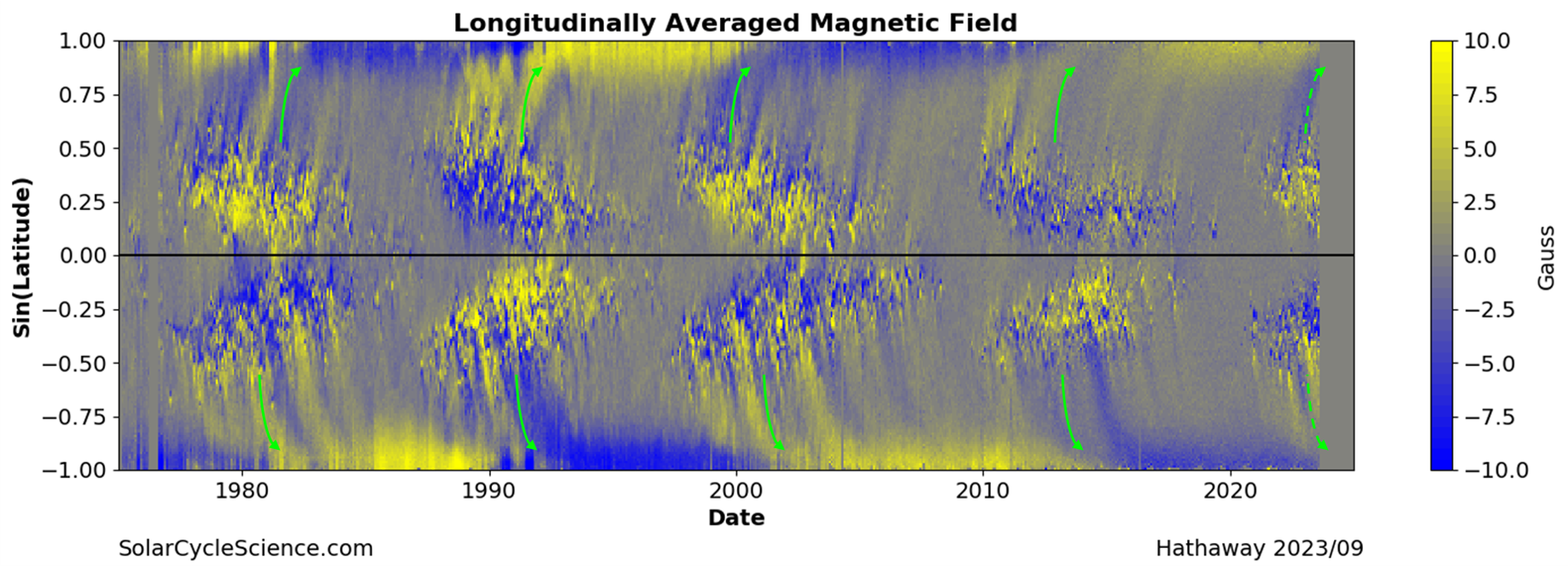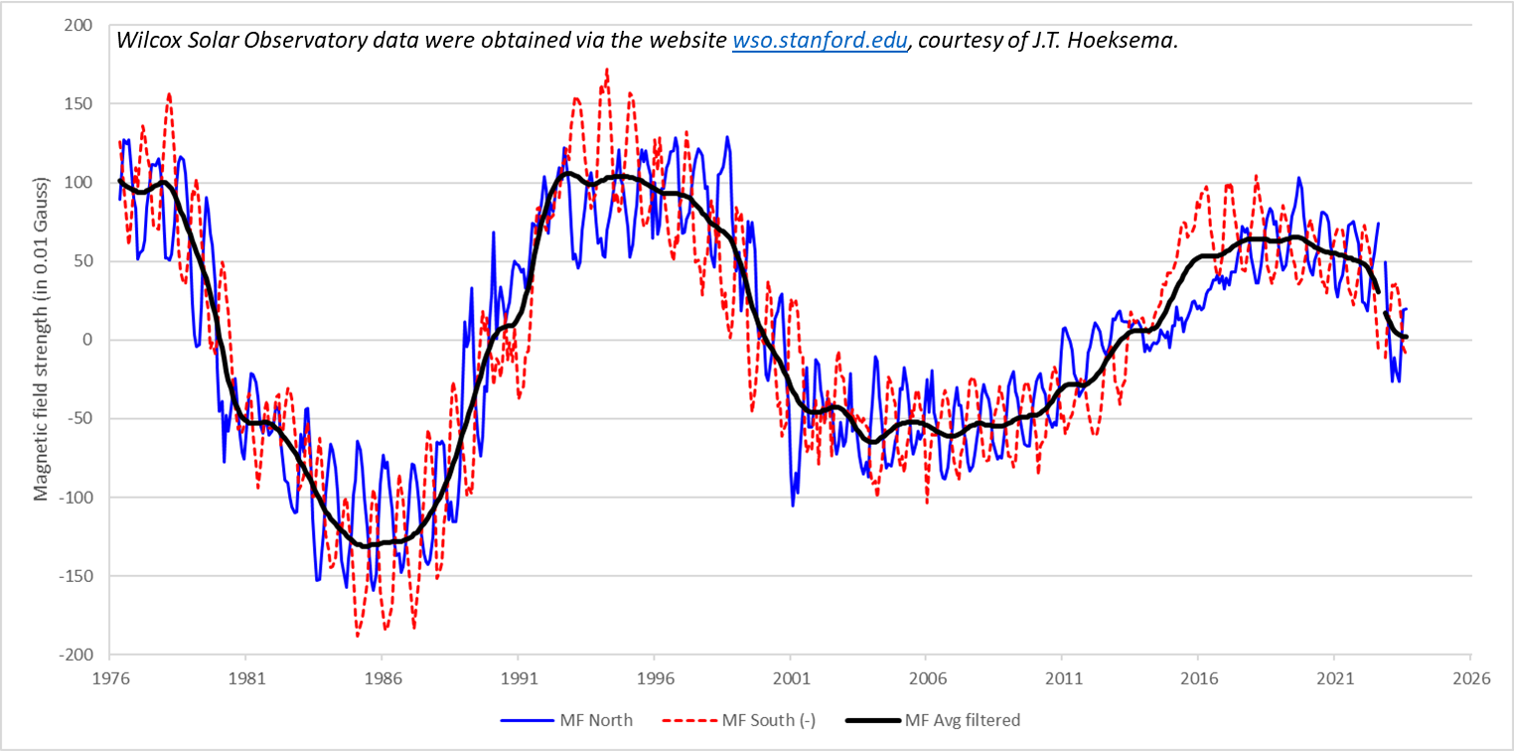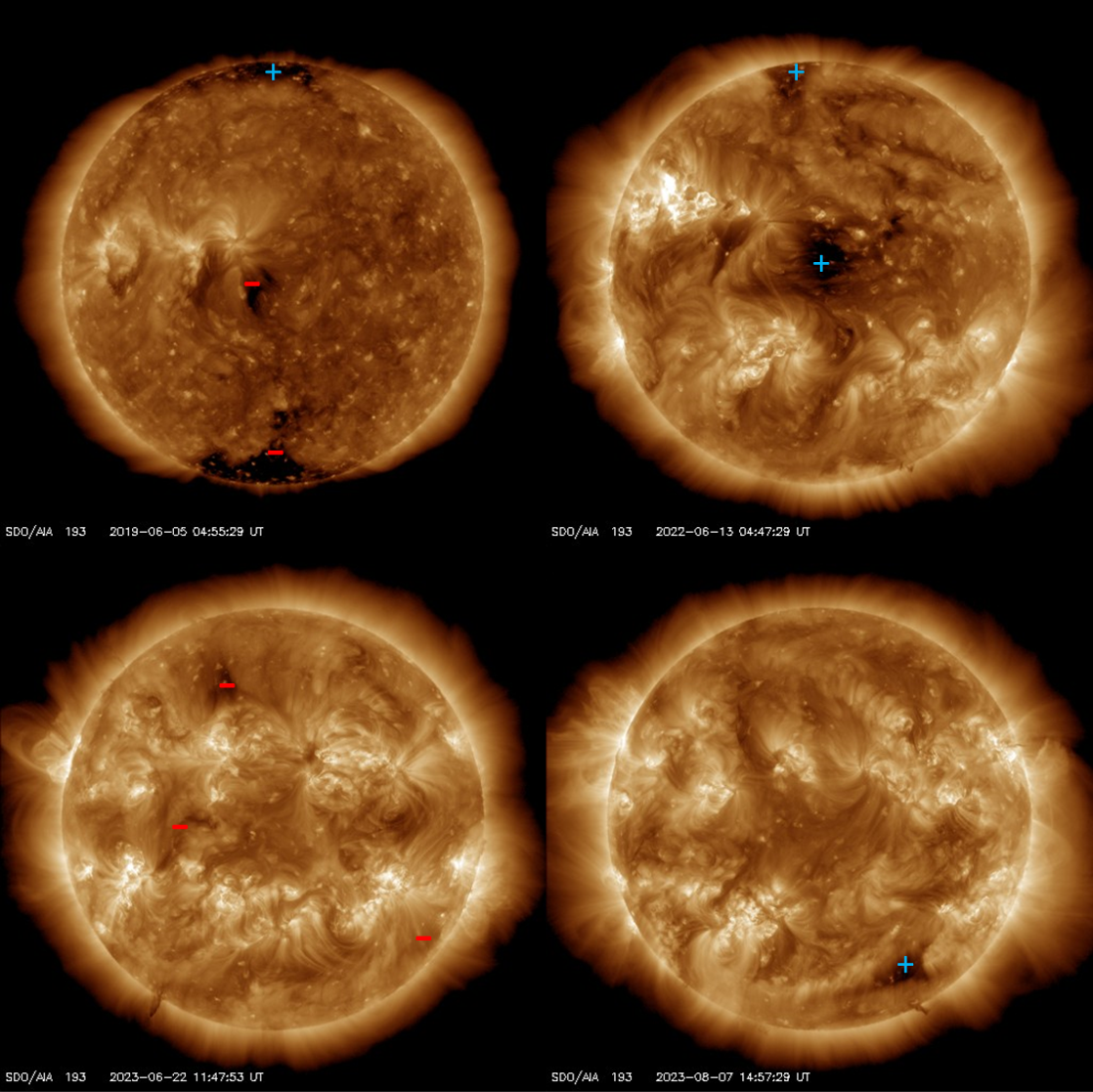Each solar cycle, during the period of maximum activity, the magnetic field at the solar poles disappears and gets replaced by a magnetic field of opposite polarity. These reversals are a key feature of the solar dynamo: the physical process that generates the Sun's magnetic field necessary for the creation of sunspots and other magnetic phenomena. This switch of the polar magnetic fields does not take place overnight. Indeed, it may take several months and longer before they are permanently established. The old polar field is replaced by opposite polarity field from the magnetic remnants of active regions, being transported towards the poles by the Sun's magnetic conveyor belt, as tree leaves floating on a rippling creek. This is a slow process as can be seen in the figure underneath from the SolarCycleScience page, annotated by green arrows indicating the movement from the active region belt towards the solar poles (yellow is positive polarity, blue negative). This reversal can take place at different times for the poles, and may also be of different duration. For example, during the previous solar cycle, the polar field reversal at the southern pole was completed in just a few months around mid-2013, whereas for the northern pole the reversal started around mid-2012 and was only completed late 2014 (Mierla et al. 2020).

Recent measurements by the Wilcox Solar Observatory (WSO) of the Sun's polar magnetic fields seem to indicate that the polar field reversal has started. In the graph underneath, polar magnetic field strength (WSO) is shown per month and per solar hemisphere (solid blue: north pole, dashed red: south pole) as well as the average value (thick black line). Note that the sign of the south polar magnetic fields has been reversed. The magnetic field strength is expressed in units of 0.01 Gauss. The ups-and-downs in the curves for the north and south polar region are due to a seasonal effect: in the course of a year, as the Earth orbits the Sun, the instruments have a better look on the Sun's southern polar region during the January-April timeframe, and a better view on the northern polar region during the July-October period. The average magnetic field strength (black curve) has been filtered such that (most of) these ups-and-downs have been removed. The graph shows that the magnetic polarity for both polar regions has already been reversed briefly, but not permanently. Based on the available data points (last 4 solar cycles), the reversal at a single pole may take 1.5 years (median), with an uncertainty of one year. In view of the different evolution of the reversals at the different poles, and because of the long time a field reversal may take, it's no suprize that for several months around solar maximum, the Sun may exhibit two poles both with the same magnetic polarity. This creates very complex magnetic structures around the Sun, which in turn affect the rest of the solar system and helps for example to further reduce access of the cosmic rays to the earth environment - see the SC25 Tracking page. When the filtered average magnetic field (black curve) reaches 0 Gauss, it usually takes another 6 months (median) before the smoothed monthly international sunspot number (ISN - SILSO) reaches its maximum, albeit with an uncertainty of again 12 months. The current filtered average magnetic field strength is near 0 Gauss, but not yet. A solar cycle maximum in 2024 is certainly possible.

All this magnetic restructuring has also had its impact on the polar coronal holes, similar to what has been described in this STCE newsitem for the previous solar cycle. Indeed, since a couple of months, these polar sources of the high-speed solar wind have mostly disappeared, with only and occasionally a few weak patches of the old magnetic polarity visible. At the same time, some more prominent (though still small) coronal holes have started developing at latitudes of 50-60 degrees, but more importantly having occasionally already the new magnetic polarity. This means e.g. that at the northern polar region, the old positive magnetic polarity coronal holes have nearly disappeared, and small high-latitude negative polarity coronal holes are occasionally visible. Near the southern hemisphere, the same evolution has been observed, but with opposite polarities. See the annotated SDO/AIA 193 images underneath showing the mature resp. small polar coronal holes in June 2019 resp. June 2022, and the small high-latitude opposite polarity coronal holes during the summer of 2023. The "+" and "-" signs indicate positive resp. negative magnetic polarity as indicated on the NOAA/SWPC solar synoptic maps (Compilation). So, the currently small-sized high-latitude coronal holes are expected to further develop during and after the polar field reversal, to fully establish fresh polar coronal holes but with a magnetic polarity opposite to that of the previous solar cycle, i.e. a northern polar coronal hole with a negative instead of a positive magnetic polarity, and a southern polar coronal hole with a positive instead of a negative magnetic polarity. But please don't leave your sleep for it: it's going to take a year or two before those new polar coronal holes will have fully matured.

The clip underneath shows the evolution of the overall solar magnetic field for each year since 2010 around 5 June, represented by a selection of field lines that have been computed from the long-running PFSS model at the Lockheed Martin Solar and Astrophysics Laboratory (LMSAL). The Potential-field Source-surface (PFSS) model provides a simple and effective tool for the large-scale features of the global coronal magnetic field. The color of the fieldlines is based on whether they are closed (white) or open (green or magenta, representing positive ("outgoing") resp. negative ("returning") magnetic polarity). The surface magnetic map is based on a flux-transport model of the solar photosphere, with magnetogram data from SDO/HMI inserted at regular intervals (Schrijver and DeRosa, 2003). The clip nicely captures the polar field reversal during the previous solar cycle, as well as that it takes a while before a new stable dipolar structure has been established. The last frames also indicate a new polar field reversal is at hand. Note similar clips can be made with the SWHelioviewer software (SWHV), which uses a slightly different model and a different source for the magnetograms.






